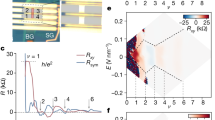Abstract
Although the properties of most superconducting materials are well described by the theory1 of Bardeen, Cooper and Schrieffer (BCS), considerable effort has been devoted to the search for exotic superconducting systems in which BCS theory does not apply. The transition to the superconducting state in conventional BCS superconductors involves the breaking of gauge symmetry only, whereby the wavefunction describing the Cooper pairs—the paired electron states responsible for superconductivity—adopt a definite phase. In contrast, a signature of an unconventional superconducting state is the breaking of additional symmetries2, which can lead to anisotropic pairing (such as the ‘d-wave’ symmetry observed in the copper oxide superconductors) and the presence of multiple superconducting phases (as seen in UPt3 and analogous behaviour in superfluid 3He; 3–5). Here we report muon spin-relaxation measurements on the superconductor Sr2RuO4 that reveal the spontaneous appearance of an internal magnetic field below the transition temperature: the appearance of such a field indicates that the superconducting state in this material is characterized by the breaking of time-reversal symmetry. These results, combined with other symmetry considerations, suggest that superconductivity in Sr2RuO4 is of ‘p-wave’ (odd-parity) type, analogous to superfluid 3He.
This is a preview of subscription content, access via your institution
Access options
Subscribe to this journal
Receive 51 print issues and online access
$199.00 per year
only $3.90 per issue
Buy this article
- Purchase on Springer Link
- Instant access to full article PDF
Prices may be subject to local taxes which are calculated during checkout


Similar content being viewed by others
References
Bardeen, J., Cooper, L. N. & Schrieffer, J. R. Theory of superconductivity. Phys. Rev. 108, 1175–1204 (1957).
Sigrist, M. & Ueda, K. Phenomenological theory of unconventional superconductivity. Rev. Mod. Phys. 63, 239–311 (1991).
Lee, D. M. The extraordinary phases of liquid 3He. Rev. Mod. Phys. 69, 645–665 (1997).
Osheroff, D. D. Superfluidity in 3He: discovery and understanding. Rev. Mod. Phys. 69, 667–681 (1997).
Richardson, R. C. The Pomeranchuk effect. Rev. Mod. Phys. 69, 683–690 (1997).
Randall, J. J. & Ward, R. J. The preparation of some ternary oxides of the platinum metals. J. Am. Chem. Soc. 81, 2629–2631 (1959).
Maeno, Y. et al. Superconductivity in a layered perovskite without copper. Nature 372, 532–534 (1994).
Mackenzie, A. P. et al. Extremely strong dependence of superconductivity on disorder in Sr2RuO4. Phys. Rev. Lett. 80, 161–164 (1998).
Mackenzie, A. P. et al. Quantum oscillations in the layered perovskite superconductor Sr2RuO4. Phys. Rev. Lett. 76, 3786–3789 (1996).
Vollhardt, D. & Wölfle, P. The Superfluid Phases of Helium 3 (Taylor & Francis, London, (1990)).
Rice, T. M. & Sigrist, M. Sr2RuO4: an electronic analogue of 3He? J. Phys. Condens. Matter 7, 643–648 (1995).
Baskaran, G. Why is Sr2RuO4not a high Tcsuperconductor? Electron correlation, Hund's coupling and p-wave instabiity. Physica B 223 & 224, 490–495 (1996).
Nishizaki, S., Maeno, Y., Farner, S., Ikeda, S. & Fujita, T. Pairing symmetry of superconducting Sr2RuO4from specific heat measurements. Physica C 282–287;, 1413–1414 (1997).
Ishida, K. et al. Anisotropic pairing in superconducting Sr2RuO4: Ru NMR and NQR studies. Phys. Rev. B 56, R505–R508 (1997).
Sigrist, M. & Zhitomirsky, M. E. Pairing symmetry of the superconductor Sr2RuO4. J. Phys. Soc. Jpn 65, 3452–3455 (1996).
Machida, K., Ozaki, M. & Ohmi, T. Odd-parity pairing superconductivity under tetragonal symmetry—possible application to Sr2RuO4. J. Phys. Soc. Jpn 65, 3720–3723 (1996).
Agterberg, D. F., Rice, T. M. & Sigrist, M. Orbital dependent superconductivity in Sr2RuO4. Phys. Rev. Lett. 78, 3374–3377 (1997).
Brewer, J. H. in Encyclopedia of Applied Physics Vol. 11(ed. Trigg, G. L.) 23 (VCH, New York, (1994)).
Kiefl, R. F. et al. Search for anomalous internal magnetic fields in high-Tcsuperconductors as evidence for broken time-reversal symmetry. Phys. Rev. Lett. 64, 2082–2085 (1990).
Luke, G. M. et al. Muon spin relaxation in UPt3. Phys. Rev. Lett. 71, 1466–1469 (1993).
Heffner, R. H. et al. New phase diagram for (U,TH)Be13: a muon-spin-resonance and Hc1study. Phys. Rev. Lett. 65, 2816–2819 (1990).
Heffner, R. H. & Norman, M. R. Heavy fermion superconductivity. Comments Condens. Matter Phys. 17, 361–408 (1996).
Uemura, Y. J., Yamazaki, T., Harshman, D. R., Senba, M. & Ansaldo, E. J. Muon-spin relaxation in AuFe and CuMn spin glasses. Phys. Rev. B 31, 546–563 (1985).
Acknowledgements
We thank K. Machida, D. Agterberg and E. M. Forgan for discussions. Research at Columbia was supported by NSF and NEDO. Y.M. and Z.Q.M. thank CREST of the Japan Science and Technology Corporation for its support.
Author information
Authors and Affiliations
Corresponding author
Rights and permissions
About this article
Cite this article
Luke, G., Fudamoto, Y., Kojima, K. et al. Time-reversal symmetry-breaking superconductivity in Sr2RuO4. Nature 394, 558–561 (1998). https://doi.org/10.1038/29038
Received:
Accepted:
Issue Date:
DOI: https://doi.org/10.1038/29038
This article is cited by
-
Unconventional superconductivity in Cr-based compound Pr3Cr10−xN11
npj Quantum Materials (2024)
-
Hidden magnetism uncovered in a charge ordered bilayer kagome material ScV6Sn6
Nature Communications (2023)
-
Spontaneous superconducting diode effect in non-magnetic Nb/Ru/Sr2RuO4 topological junctions
Communications Physics (2023)
-
Tunable unconventional kagome superconductivity in charge ordered RbV3Sb5 and KV3Sb5
Nature Communications (2023)
-
The search for spontaneous edge currents in Sr2RuO4 mesa structures with controlled geometrical shapes
Scientific Reports (2023)
Comments
By submitting a comment you agree to abide by our Terms and Community Guidelines. If you find something abusive or that does not comply with our terms or guidelines please flag it as inappropriate.



